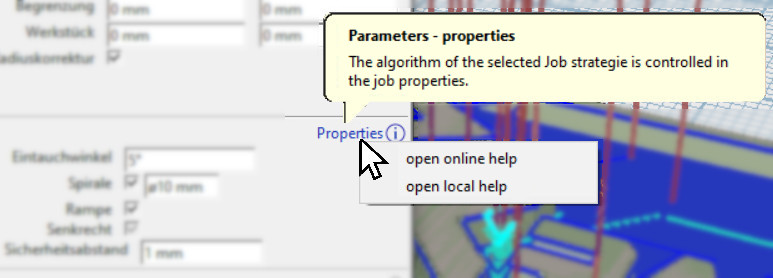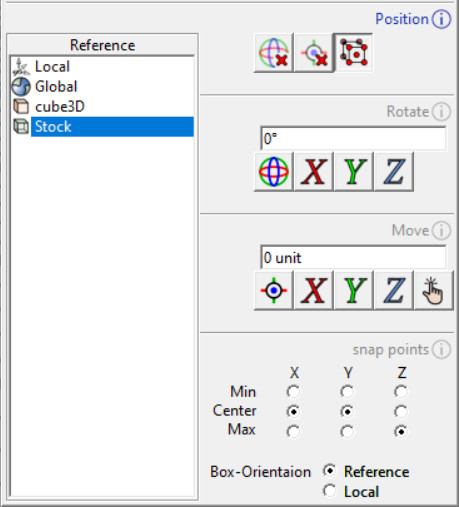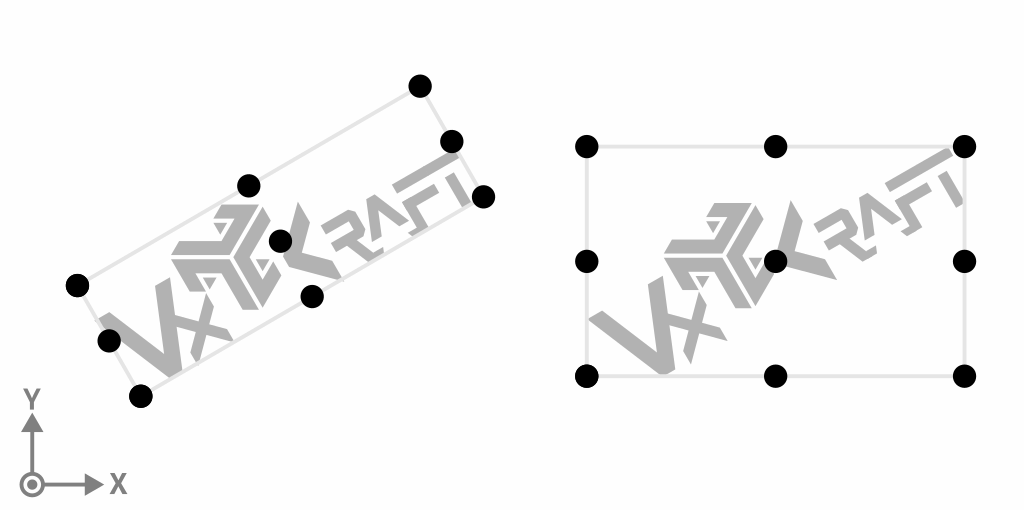User interface (GUI)
The user interface, also known as the Graphical User Interface (GUI), is the central aspect of any program to allow efficient and intuitive interaction between the user and the software. This chapter covers the various elements of the GUI, starting with general elements relevant to all areas, followed by the main window and smaller, more specific dialog boxes. Finally, the available key combinations (shortcuts) for faster and more efficient operation of the user interface are presented.
General GUI elements
 © vxcraft.com
© vxcraft.comQuickinfos
Quickinfos are small, blue info icons (a small "i" in a circle) distributed throughout the program to provide you with additional information about the respective elements. When you move the mouse pointer over such an info icon, a short description about the topic is displayed as a tooltip. Clicking on the info icon will take you to the detailed explanation in the manual. You have the option to choose between the online manual and the local manual, depending on your preferences and the availability of an Internet connection.
 © vxcraft.com
© vxcraft.comTooltips
Tooltips are seamlessly integrated into the program and appear when the mouse pointer hovers over icons, labels, titles and other common GUI elements. They provide a brief explanation of the function or meaning of the element in question. If you need more information, look for the nearest tooltip icon.
Numeric input fields
In numerical input fields, both direct numerical values and simple mathematical formulas can be entered. To change the value of a field, hold down the left mouse button and move the mouse up or down. This function is not available for formulas and can be disabled in the settings if desired. Alternatively, you can use the arrow and scroll keys to increment the value. To confirm the entered value or formula, press Enter or F5. When the focus leaves the input field, the input is also confirmed.
Input fields
In the Script window, you can enter text to run scripts. To validate the entered text and execute the script, press Enter or F5. When the focus leaves the input field, the script will also be validated and executed.
GUI-Element "Status bar"
The status bar is a GUI element that displays general information about the mouse coordinates and other info. Optionally, there is a progress bar on the right side, which offers the possibility to cancel the current calculation. During a calculation the progress bar is activated and the title of the current calculation process appears to inform the user about the progress of the calculation.
Tab "Positioning"
 © vxcraft.com
© vxcraft.comPositioning tools
Position and align objects (Models, stock, NcPack/NC-Zero Point,...) in 3D space using positioning tools and references.To do this, various tools and settings are available that influence or reset the behavior of the positioning.
Reference list
Select a reference to align the object to, or use special references for a local or global axis movement.
The reference list makes it possible to select a reference as a positioning aid. By selecting a reference, the object can be aligned to the reference or its axes can be used for the direction of movement. In addition, there are two special references:
- Local: When this special reference is selected, the object is moved and rotated along its own axes.
- Global: When this special reference is selected, the object is moved along the global axes and rotated.
Activate snap points
Displays a table of snap points of the reference that can be used for precise positioning of the object.
For more information on snap points and how to use them, see the "Snap points" section in the manual.
Reset position
Resets the position of the object to the global origin.
The object is moved to the starting point of the 3D space and all previous positioning is discarded. The object rotation remains.
Reset rotation
Resets the rotation of the object to the global axis orientation.
All previous rotations are discarded and the object is displayed in its original orientation according to the global coordinate axes.
Rotate <PRO>
Rotates the object by the specified number of degrees relative to the selected axis of the reference. Right-click on the desired axis to rotate the object in the opposite direction.
The "Rotate" function allows to rotate the object around the actuated axis (X, Y<PRO> or Z <PRO>) in the number of degrees entered in the input field. The rotation is relative around the selected axis of the reference. If the "local" tool is selected in the reference list, the object uses its own axis orientation, if "global" is selected, it uses the global axis orientation. If an object is selected as a reference, the axis orientation of the reference object is used.
Align rotation
Aligns the rotation of the object with the reference.
The "Align Rotation" function transfers the rotation of the reference to the object so that the object points in the same direction as the reference. The position of the object is not changed. This function is useful if the object is to be adapted to certain orientations of reference objects.
Move
Moves the object relatively by the specified value along the selected axis of the reference. By right-clicking on the desired axis, the object can be moved in the opposite direction.
The "Move" function enables the object to be moved along the actuated axis (X, Y or Z) by the value entered in the input field. The displacement is relative along the selected axis of the reference. If the "local" tool is selected in the reference list, the object uses its own axis alignment, if "global" is selected, it uses the global axis alignment. If an object is selected as a reference, the axis orientation of the reference object is used.
Align position
Aligns the position of the object with the selected reference.
The "Align Position" function allows you to align the position of the object with the selected reference. With local reference this function has no effect. If "global" is selected in the reference list, the object is set to the origin of the 3D space (world origin). If an object is selected as reference, the position of the object is set to the reference. Both objects share the same position in this case. Positioning does not affect the rotational orientation of the object.
Place object
Places the object at the selected target point in the render window. An alternative origin point can be selected by holding the Ctrl key.
The "Place Object" function allows you to place the object at a target point selected in the render window. In the default mode, the object origin jump is set directly to the clicked target point. In alternative mode, which is activated by holding down the Ctrl key, an alternative object origin jump can be selected with the right mouse button before the target point is set with another click. The Esc key can be used to cancel the selection at any time.
 © vxcraft.com
© vxcraft.comright: Box orientation: Local
Snap points
By means of the snap table, the object origin can be set at a snap point of an imaginary box enclosing the reference object.
Three values are available for each of the three axes (X, Y and Z): the minimum (Min) of the box, the center (middle) of the box and the maximum (Max) of the box.
Box orientation:
Reference: The box is oriented to the selected reference.
Local: The box is oriented to the object to be positioned.
Tab "Rendering"
Rendering
Controls the appearance of the object in the render window. Not every object has access to all of the options listed here.Line style
Controls the line style of the object.| Style | Description |
|---|---|
| Solid | The object is rendered as a solid line. |
| Dots | A dot is rendered at the beginning and end of each line segment. The line itself is hidden. |
| Solid + Dots | The two modes line and points are rendered together. |
Color
Colors the model geometry with the set color.
Cutting edge
Colors the cutting edge with the set color.
Color rapid
All rapid movements in the calculated toolpath are displayed with this color.
Color feed rate
All segments in the calculated toolpath with milling feed rate are displayed with this color.
Accent color
Highlights special features of the object.
Model color simulation
Determines the color of the resulting stock, as well as the simulation ablation model.
